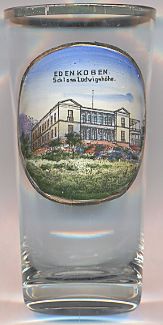

|
| DEUTSCHLAND | GERMANY |
| Bundesland: Rheinland-Pfalz | Rhineland-Palatinate |
| Landkreis: Südliche Weinstraße |
 Edenkoben is situated at an elevation of 149 m in the eastern slopes of the Pfälzer Wald low mountain region.
The city of Edenkoben has a population of about 6,700 and is also the seat of the seat of the municipality (Verbandsgemeinde) Edenkoben
which comprises Altdorf, Böbingen, Burrweiler, Edenkoben, Edesheim, Flemlingen, Freimersheim, Gleisweiler, Gommersheim,
Großfischlingen, Hainfeld, Kleinfischlingen, Rhodt unter Rietburg, Roschbach, Venningen and Weyher in der Pfalz.
Edenkoben is situated at an elevation of 149 m in the eastern slopes of the Pfälzer Wald low mountain region.
The city of Edenkoben has a population of about 6,700 and is also the seat of the seat of the municipality (Verbandsgemeinde) Edenkoben
which comprises Altdorf, Böbingen, Burrweiler, Edenkoben, Edesheim, Flemlingen, Freimersheim, Gleisweiler, Gommersheim,
Großfischlingen, Hainfeld, Kleinfischlingen, Rhodt unter Rietburg, Roschbach, Venningen and Weyher in der Pfalz.
The earliest written document that mentions Zotingkowe is the Lorsch Codex which was written between 1167 and 1190; the entry mentioning Edenkoben refers to the year 769. In th 16th century Edenkoben became part of the Electoral Palatinate. Between 1794 and 1815, the territories west of the rover Rhine became part of France, and Edenkoben was made the capital (chef-lieu) of a canton within the département Mont-Tonnerre (Donersberg). After the Congress of Vienna of 1815, the Palatinate became part of the kingdom of Bavaria. In 1933 the region became part of the Gau Saar-Pfalz (1940 Gau Westmark). Since 1946 it is part of the German state of Rheinland-Pfalz (Rhineland-Palatinate).
The  Villa Ludwigshöhe [left]
was built in 1846–1852 as a summer residence for King Ludwig I of Bavaria.
The original plans were designed by the architect Friedrich Wilhelm von Gärtner. After Gärtner's death in 1847 the
construction was supervised by Leo von Klenze. The villa was completed only in 1852, four years after Ludwighad abdicated
in favour of his son, Maximilian II. Ludwig visited Edenkoben every other year and stayed for several weeks
during the months of July and August. His last visit was in 1866. A narrow gauge railway, which connected the depot in Edenkoben
with Villa Edenkoben, opened in 1936. However, the line was closed in 1954. Since 1975 the villa is owned by the
state of Rheinland-Pfalz. Today, the villa is used for concerts and also houses the Max Slevogt Gallery, a branch of the
State Museum of Mainz.
Villa Ludwigshöhe [left]
was built in 1846–1852 as a summer residence for King Ludwig I of Bavaria.
The original plans were designed by the architect Friedrich Wilhelm von Gärtner. After Gärtner's death in 1847 the
construction was supervised by Leo von Klenze. The villa was completed only in 1852, four years after Ludwighad abdicated
in favour of his son, Maximilian II. Ludwig visited Edenkoben every other year and stayed for several weeks
during the months of July and August. His last visit was in 1866. A narrow gauge railway, which connected the depot in Edenkoben
with Villa Edenkoben, opened in 1936. However, the line was closed in 1954. Since 1975 the villa is owned by the
state of Rheinland-Pfalz. Today, the villa is used for concerts and also houses the Max Slevogt Gallery, a branch of the
State Museum of Mainz.
![[scale]](lineal.jpg)